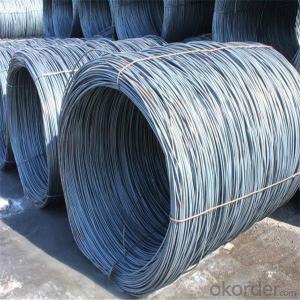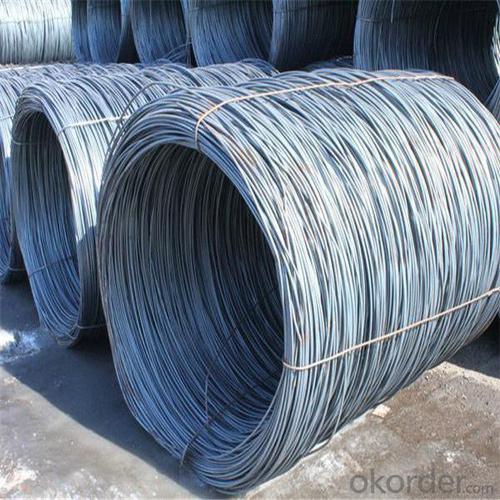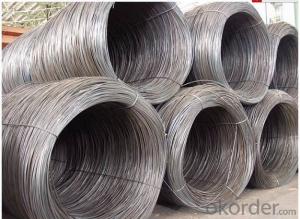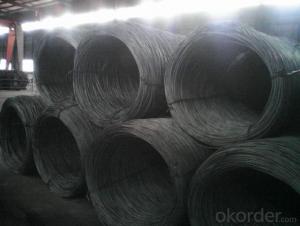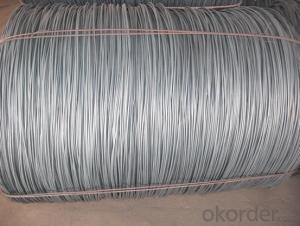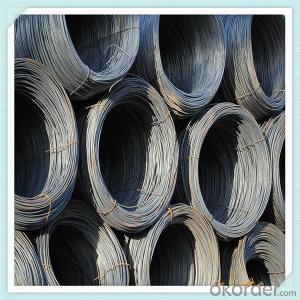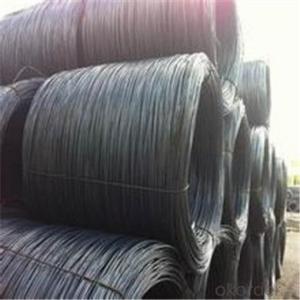Steel wire rod hot sale 5.5-14mm from mill directly
- Loading Port:
- China main port
- Payment Terms:
- TT OR LC
- Min Order Qty:
- 50 m.t.
- Supply Capability:
- 16532 m.t./month
OKorder Service Pledge
OKorder Financial Service
You Might Also Like
Specification
Produced from billets at the rolling mill, wire rod is the basis of all steel wire, rope and fencing products.
The most important characteristic in determining wire rod’s end use is its drawability. Common low carbon
wire rod is used for nails, small shaped products, barbed wires, various wire nettings, steel chains, and other
applications. High Carbon wire rod uses include steel tire cords for automobiles, conveyor belts, and pressure
hoses. Other applications include bolts, nuts, and machine parts, as well as compression, tension and torsion springs.
Our Advantage: High quality steel products from 1 class mills in
Reasonable price
Professionalism of the products
On-time delivery
Complete documents and certificates
Sincere service to meet our clients' requirements
Product Description :
Standard | AISI, ASTM, BS, DIN, GB, JIS |
Material/steel grade | Q195-Q235,SAE1006B,SAE1006CR, SAE1008B, SAE1008CR, SAE1010B, SAE1018B, or according to customers requirements |
Wire Gauge | 5.5-12mm |
Coil weight | 1.8-2.1mts |
MOQ | 25MT |
Delivery Time | 15-30 days after receipt of L/C or deposit by T/T |
Packing | In coil and load in container, if large quantity, by bulk vessel; Can be packed as customers' special requirements |
Payment terms | 1).100% irrevocable L/C at sight. 2).30% T/T prepaid and the balance against the copy of B/L. 3).30% T/T prepaid and the balance against L/C |
Application | widely used in machinery parts, manufacturing industry, electronics industry, metal tools and others |
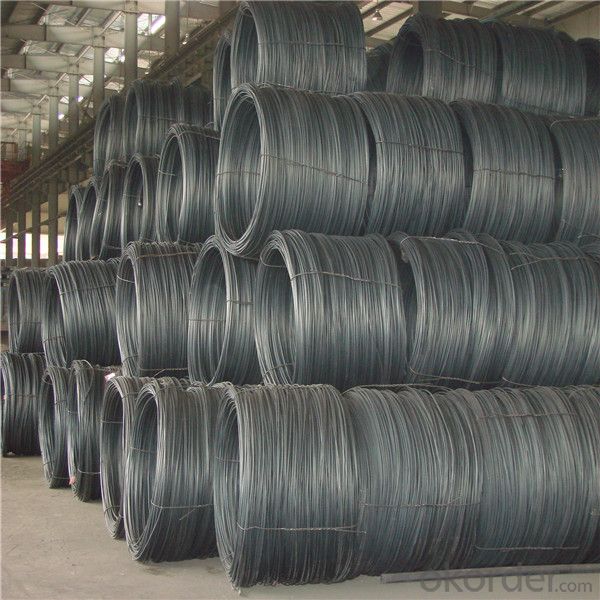
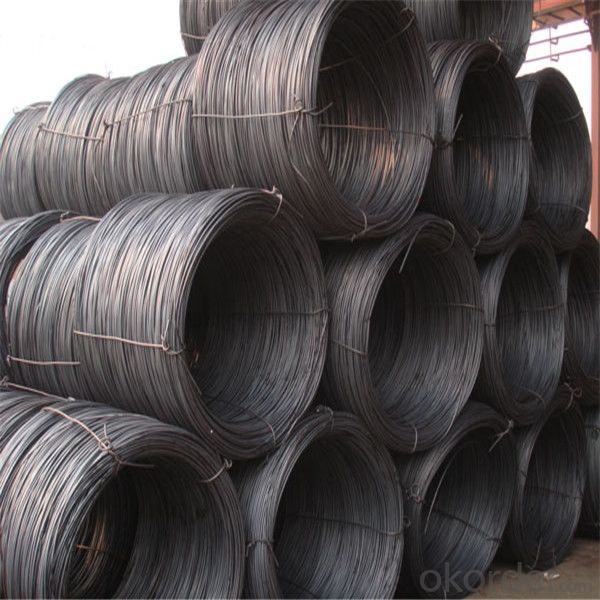

Application :
It generally used in braiding the hose for bathing product and machinery. With it
good flexibility, resistant to high temperature and resistant to corrosion, it
used widely in many industries.
Packing :
Hot-rolled wire rod is held in a unit with at least four steel straps in the
transverse direction and transported and stored without further packaging.
Before
the steel strapping is applied, the wire rod must be sufficiently compressed.
The strapping is fixed in the transverse direction with a single circumferential
strap so that the strapping does not slip and cause the coil to come apart.


Our service:
(1) We cooperate with famous factories with advanced equipment and well trained workers.
(2) We can provide factory price with trading company service.
(3) We continuously work on the improvement of our processes, guaranteeing
consistently high standards of quality to keep none compensation.
(4) We guarantee 24 hours response and 48 hours solution providing service.
(5) We accept small order quantity before formal cooperation.
(6) We deliver the agreed quality at the agreed time, reacting to changes in
customer wishes in a flexible way.
(7) Due to our volume and selling power, we have excellent freight rates with
shipping lines.
(8) We strive to always be fair and honest in our dealings with customers.
(9) We strive to work together with customers to achieve much more than we can
achieve alone.
(10) Through our passion and commitment we aim to be a market leader in all our
key markets. To maintain our position as market leader we must continue to add
value in all that we do.
FAQ:
1.Q: What's your MOQ(minimum order quantity)?
A: One full container, mixed acceptable .
2. Q: What's your packing methods?
A: Packed in bundle or bulk ..
3. Q: How can I buy CNBM products in my country?
A:Please send us an inquiry or email ,we will reply to you if there is distributor in your country
4. Q: Can we visit your factory?
A: Warmly welcome. Once we have your schedule, we will arrange the
professional sales team to follow up your case.
5. Q: How long does it take to get the product if i place an order?
A:With the process of your requirements,we will pack and deliver in 3
-7 days. If it is by sea shipment,it will take 15-45 days depending on different locations
- Q: How does the brittleness of steel wire rod vary with different heat treatment processes?
- The brittleness of steel wire rod can vary significantly with different heat treatment processes. Heat treatment involves subjecting the steel wire rod to specific temperature and time conditions to alter its microstructure and consequently its mechanical properties. One commonly used heat treatment process is annealing, which involves heating the steel wire rod to a specific temperature and then slowly cooling it. This process helps to relieve internal stresses, refine the microstructure, and improve the ductility of the wire rod. As a result, annealed steel wire rod tends to have reduced brittleness and increased toughness. On the other hand, quenching is another heat treatment process that involves rapidly cooling the steel wire rod after heating it to a specific temperature. Quenching can result in the formation of a hardened microstructure, known as martensite, which can increase the strength of the wire rod. However, this process can also increase the brittleness of the material. Therefore, quenched steel wire rod tends to be more brittle compared to annealed wire rod. Another heat treatment process, known as tempering, is often used in conjunction with quenching to reduce the brittleness of the wire rod. Tempering involves reheating the quenched wire rod to a lower temperature, which allows for the redistribution of internal stresses and the transformation of some of the martensite into a more ductile microstructure. This process helps to improve the toughness and reduce the brittleness of the wire rod. In summary, the brittleness of steel wire rod can be influenced by different heat treatment processes. Annealing generally reduces brittleness and improves ductility, while quenching can increase brittleness but enhance strength. Tempering can then be used to reduce brittleness after quenching. The selection of the appropriate heat treatment process depends on the desired mechanical properties and the intended application of the steel wire rod.
- Q: How is steel wire rod used in the manufacturing of wire for shopping baskets?
- The manufacturing process of wire for shopping baskets heavily relies on steel wire rod. This rod acts as the primary material that undergoes a series of manufacturing steps to transform into wire. Initially, the steel wire rod is heated and passed through a set of rollers to gradually decrease its thickness and increase its length. This particular procedure, known as drawing, enhances the wire's tensile strength and flexibility. After the wire is drawn, it is typically coated with a protective layer to prevent corrosion and enhance its durability. This coating can be composed of materials such as zinc or plastic. Subsequently, the coated wire is shaped into the desired form, which is usually a mesh-like structure for shopping baskets. This shaping process, called welding, involves bending and joining the wire at specific points to form the basket shape. The selection of steel wire rod for manufacturing wire for shopping baskets is based on its strength, resilience, and ability to endure heavy loads. It ensures that the shopping baskets remain sturdy enough to carry various items without bending or breaking. Furthermore, the corrosion resistance properties of the steel wire rod guarantee a longer lifespan for the wire and ultimately the shopping baskets, even when exposed to moisture or challenging environments. In conclusion, steel wire rod plays a vital role in the manufacturing process of wire for shopping baskets. It serves as the fundamental raw material that is transformed into wire, which is then coated, shaped, and welded to create the final product. The strength, resilience, and corrosion resistance of the steel wire rod ensure that the shopping baskets are durable, long-lasting, and capable of withstanding the demands of everyday use.
- Q: What are the different types of steel wire rod coatings used for improved adhesion?
- There are several types of steel wire rod coatings used for improved adhesion, including zinc coatings, polymer coatings, and galvanized coatings. Zinc coatings, such as hot-dip galvanizing, provide excellent corrosion resistance and adhesion. Polymer coatings, like epoxy or polyethylene, offer enhanced adhesion and impact resistance. Galvanized coatings, which combine zinc with other metals like aluminum or nickel, provide both corrosion protection and improved adhesion. These different types of coatings are used to enhance the performance and durability of steel wire rods in various industries.
- Q: What are the major players in the global steel wire rod market?
- ArcelorMittal, Nippon Steel Corporation, Tata Steel Ltd., POSCO, JFE Steel Corporation, Nucor Corporation, Steel Authority of India Limited (SAIL), EVRAZ plc, Gerdau S.A., and Sohar Steel LLC are among the key players in the global steel wire rod market. These companies are renowned manufacturers and suppliers of steel wire rod, which finds extensive application in industries like construction, automotive, and manufacturing. They possess a significant market share and maintain a strong presence in vital markets worldwide. To stay competitive, these industry leaders consistently invest in research and development to develop innovative products and enhance their production processes. They also prioritize strategic alliances, acquisitions, and expansion initiatives to broaden their market reach and fortify their position in the global steel wire rod market.
- Q: What are the common industry standards for steel wire rod suppliers?
- The common industry standards for steel wire rod suppliers typically include specifications related to the chemical composition, mechanical properties, and dimensional requirements of the wire rods. These standards may vary depending on the specific application and region, but some commonly followed standards include ASTM A510, ISO 16120-1, and JIS G 3505. Compliance with these standards ensures the quality and consistency of steel wire rods supplied by manufacturers.
- Q: What are the different cleanliness testing methods for steel wire rod?
- In the industry, multiple cleanliness testing methods are commonly employed to assess the quality of steel wire rods. These methods aid in determining the presence of impurities and contaminants on the surface, ensuring its suitability for various applications. Some of the cleanliness testing methods for steel wire rods are as follows: 1. Visual Inspection: This method is the simplest and most fundamental. It involves visually examining the surface of the wire rod for visible impurities such as scale, rust, or foreign particles. 2. Magnetic Particle Inspection (MPI): MPI is a non-destructive testing method that utilizes magnetic fields and iron particles to detect surface and near-surface defects on the wire rod. It is particularly effective in identifying cracks, seams, or other imperfections that may compromise the integrity of the wire rod. 3. Eddy Current Testing: Eddy current testing is another non-destructive method that employs electromagnetic induction to detect surface defects and variations in conductivity. It can identify defects such as cracks, pits, or variations in material composition that may affect the quality and performance of the wire rod. 4. Ultrasonic Testing: Ultrasonic testing entails the utilization of high-frequency sound waves to detect internal and surface defects in the wire rod. It can uncover flaws such as voids, inclusions, or discontinuities that may weaken the structural integrity of the wire rod. 5. Chemical Analysis: Chemical analysis involves the use of various laboratory techniques to determine the chemical composition of the wire rod. It can identify impurities, such as sulfur, phosphorus, or other elements that may impact the mechanical properties and corrosion resistance of the wire rod. 6. Microscopic Examination: Microscopic examination involves magnifying the surface of the wire rod using optical or electron microscopes and analyzing it at a microscopic level. This method aids in identifying surface defects, inclusions, or other anomalies that may affect the performance of the wire rod. By utilizing these diverse cleanliness testing methods for steel wire rods, manufacturers and end-users can ensure that the material meets the required cleanliness standards and specifications, guaranteeing its quality and suitability for its intended use.
- Q: What is the difference between a wire rod and a straight bar?
- Straight line refers to the production, delivery is a bundle of straight material delivery in winter, used for the diameter of coarse steel bar, general specifications of 9 meters and 12 meters, the dosage is large (1000 tons or more), steel mills will consider the order made
- Q: How are surface defects in steel wire rod repaired?
- Different methods can be used to repair surface defects in steel wire rods, depending on the type and extent of the defect. Common defects include scale, cracks, pits, and scratches. The following are some techniques used to address these defects: 1. Grinding and polishing: Scratches and pits can be repaired through grinding and polishing. This involves removing the damaged layer of steel and using abrasive tools to smooth the surface. The process is repeated until the defect is completely eliminated, and the surface achieves the desired finish. 2. Heat treatment: Heat treatment can be employed to repair cracks. This method involves subjecting the steel wire rod to controlled heating and cooling processes, which alter its physical and mechanical properties. Heat treatment helps close the cracks and enhance the overall integrity of the wire rod. 3. Mechanical removal: Mechanical removal methods are used for larger defects like scale or excessive surface irregularities. Specialized tools or machinery are utilized to physically remove the defective portion of the wire rod. The remaining surface is then treated to ensure it meets the required specifications. 4. Chemical treatment: Chemical treatment methods can be utilized to repair surface defects such as rust or corrosion. Appropriate chemicals or coatings are applied to the affected area to remove the corrosion and prevent further deterioration. The treated surface is then cleaned and prepared for further processing or use. It should be noted that the repair process for surface defects may vary depending on the specific requirements and standards of the steel wire rod industry. Manufacturers and technicians adhere to industry guidelines and quality control measures to ensure the repaired wire rods meet the necessary specifications for their intended applications.
- Q: What are the different types of wire products that can be made from steel wire rod?
- Steel wire rods can be transformed into a wide range of wire products, depending on their intended use and specific requirements. Some examples of these wire products include: 1. Wire mesh: Wire mesh is a versatile material made from steel wire rods that finds applications in fencing, construction, and filtration. Depending on the desired strength and durability, wire mesh can be woven or welded. 2. Wire ropes: Wire ropes, which are strong and flexible cables used for lifting, towing, and securing heavy objects, are commonly manufactured using steel wire rods. They are extensively used in industries like construction, mining, and maritime. 3. Springs: Specific mechanical properties and high tensile strength of steel wire rods make them suitable for manufacturing springs. Springs are widely used in industries such as automotive, furniture, and electronics to provide elasticity and support. 4. Fasteners: Steel wire rods can be shaped into screws, nails, and bolts, serving as essential fasteners in construction, manufacturing, and other industries. These fasteners ensure secure and reliable connections. 5. Wire forms: By bending, twisting, and shaping steel wire rods, wire forms like baskets, shelving, and display racks are created. Wire forms provide structural support and organization in various settings. 6. Wire reinforcements: Steel wire rods are commonly used as reinforcements in concrete structures like buildings, bridges, and highways. These reinforcements enhance the strength and durability of the concrete, ensuring structural integrity. 7. Wire connectors: Steel wire rods are utilized in the manufacturing of wire connectors, which are essential for joining and connecting electrical wires. These connectors guarantee efficient power transmission through secure and reliable electrical connections. 8. Wire brushes: Steel wire rods can be twisted and arranged to create wire brushes used in cleaning and polishing applications. Industries like automotive, metalworking, and janitorial services commonly use wire brushes. Overall, steel wire rods offer versatility and strength, enabling the production of various wire products that cater to diverse industries and applications.
Send your message to us
Steel wire rod hot sale 5.5-14mm from mill directly
- Loading Port:
- China main port
- Payment Terms:
- TT OR LC
- Min Order Qty:
- 50 m.t.
- Supply Capability:
- 16532 m.t./month
OKorder Service Pledge
OKorder Financial Service
Similar products
Hot products
Hot Searches
Related keywords
